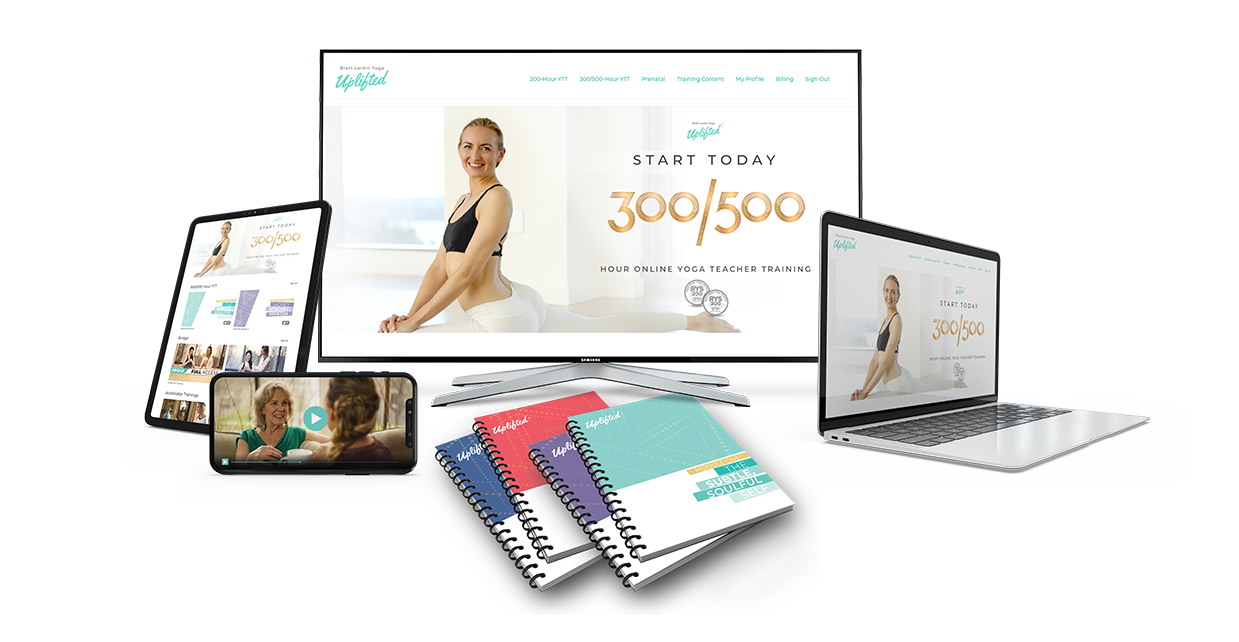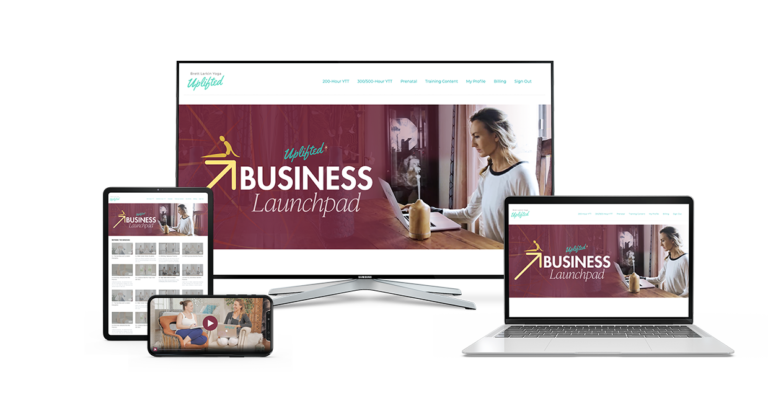You’ve done all the thinking, crunched all the numbers, and you’re finally ready to take the plunge—you want to create your own yoga business! With that comes managing cash flow and profit. If running and starting a business is relatively new to you, you might not be sure where to start with the financial aspects of it all. That’s totally ok. We’ve got you covered. As yoga teachers and students, we often want to move away from a material mindset. But yoga is a business, after all – but instead of burying your head in the sand when money matters come up, I suggest transforming your money mindset to invite abundance into your life.
In this article, we will cover the basics of yoga business finances, common accounting terms you need to know, financial planning for the future, and cultivating an abundance mindset to keep you calm and clear as you work on your books. Being able to confidently run a business has helped yoga practitioners all over the world cultivate confidence in themselves, the expression of their practice, and the ability to share their love of yoga with the community.
At the end of the day, deciding to start your own business is scary. You are taking a leap of faith and trusting yourself to go on this journey and be okay at the end of it. But, as many of us know, the scariest endeavors in life can be the most rewarding!
Approaching Yoga Business with an Abundance Mindset
We can often get bogged down by the duality of winning and losing when it comes to just about everything. If one person wins, the other must lose – right?
I’m going to challenge that. The cult of one winner is rooted in a scarcity mindset – the belief that there’s only so much pie to go around – and encourages feelings of malice, jealousy, and self-doubt (noooo thank you). I do all of my work from what’s known as an abundance mindset – including managing cash flow and profit.

An abundance mindset focuses on a shared definition of success. A person with an abundance mindset believes that there are enough resources and successes to go around. This doesn’t come naturally to many people – we are socially conditioned to compete, after all! Maintaining a healthy abundance mindset requires reflection, affirmations, meditation, and mindfulness.
Sounds like a lot of work? Well I can tell you that the benefits are more than worth it. There are soooo many good reasons to cultivate a more wholesome view of success through an abundance mindset. It will help you seize the day, uplift and empower people around you, maintain a steady sense of fulfillment regardless of circumstances, give and receive affection and affirmations with ease, and feel secure in your efforts. Life is a feast, after all – not a single pie!

If you enter your business focusing on fear of the competition, you’re programming the idea that there can only be one successful yoga business, and it’s either your business or the other business. This is the fast track to cultivating contempt towards other yoga teachers and successful wellness businesses that you could actually be learning from and partnering with.
You will be missing out on being part of a wholesome and joyous community, along with the chance to create wonderful memories you will cherish for life. An abundance mindset will help you create their business proactively, with confidence and gratitude at every step of the process, rather than fear and negativity. It also limits reactivity—e.g. making decisions based on what others are doing.
Why I Don’t Use Traditional Business Accounting Definitions
In my Business Launchpad course, I use slightly different accounting definitions than what accountants and business managers might use. I use the concept developed by Mike Michalowicz in his book, Profit First, that basically extends the abundance mindset to focusing on flexible gains, rather than fixed profits, in your business. This is real-deal behavioral economics, yogis! It’s based on Parkinson’s Law.
Parkinson’s Law: a principle that views profit as a flexible, expandable amount—not just what is left after expenses.
The Profit First approach essentially flips the script on how business owners usually consider profit: whatever’s left after deducting expenses from revenue. The traditional formula for calculating profit looks like this:
revenue – expenses = profit
With the Profit First formula, it goes like this:
revenue – profit = expenses
Basically, the difference is that from the start you are accounting for profit, taxes, and pay. Whatever is left after this is what your company has to spend on expenses. This includes things like materials, salaries, and utilities. This simple algebra shifts your focus to prioritizing your own effort and affirming your ability to attract abundance.
Another key difference between traditional profit and loss formulas and the Profit First approach is how assets and liabilities are defined.
In the Profit First mindset, you are an asset to your business. Assets are defined as sources of income or revenue. Your time is valuable, and you charge for teaching and the time you give. As you gain experience as a teacher, you should naturally charge more money for your time, increasing your income. Here are some other assets in your yoga business:
- You!
- Social media channels
- Website
- Books
- Products
There are assets that function independently of you and dependently on you. For example, a course or product that you have already made is independent of you. This can stand on its own and does not require any active time from you after it is already created. For example, a pre-recorded course. An asset that functions dependently of you is one that requires your time and engagement in the present, such as a yoga teacher training with live sessions.
In this line of thinking, anyone who works for you is also considered to be an asset. Traditionally, because paying wages decreases your profits, employees are categorized as liabilities (expenses). In this mindset, employees and contractors are assets because they free up your time to focus on boosting other streams of revenue. And it’s much more human, right?
Sooo, to summarize:
- Assets = sources of revenue
- Liabilities = expenses
People As Assets
Let’s zero in on assets and people power. Your accountant will most likely not agree with defining employees as assets. I mean – you pay employees, right? This must mean they are an expense or a liability, right? Well… for our purposes, not quite.
Let’s say that you have eight hours in a day that you are able to work. If you need to do anything outside of this, say, clean your house, edit a podcast that was finished months ago, offer emotional support to your partner, pick up your kid, and so on – you have a time problem! You need to free up time in some way to meet your personal needs.
Here’s a little thought experiment for you: If you value your time at $100 per hour and your schedule is fully booked, then anyone who you can pay to do the same job for less per hour is an asset to your business. With that hour of work covered for less than it cost you to perform, you can perform another hour of work at $100, thus boosting your bottom line.
You can only work so many hours in a day, so it’s important to prioritize the tasks and hourly rate at which you are charging for your services. Content creation is a huge part of this. While you may not be making a profit that second during the content creation process, you have to think about what the hourly rate will average out to be retrospectively.
For example, if you spend 20 hours creating a course that generates $1000, then your hourly rate is $50. If you are able to hire someone else to do tasks during your content creation period that frees you up to make the course for less than $50 per hour, then they are an asset to your business.
What Is Cash Flow?
Cash flow is simply the movement of money in and out of your business. For example, if you sell two courses for $50 each, your incoming cash flow is $100. If you then spend $20 on advertising, outflowing money is $20. This flow of money in and out of your business is known as your cash flow.
Why Does Cash Flow Matter to Your Yoga Business?
In business, your cash flow matters more than your profit. Yep, that’s right! Why? Because cash flow is what keeps your business running. For example, you may make an increase in revenue, but increase your expenses by twice as much. If you’re not attentive to what’s coming in and going out, you’ll get into debt.
All business problems can be solved by maintaining a healthy cash flow! You should not spend more than you earn (unless this is part of your business plan), and you should make sure you have enough working capital to pay for expenses without going into debt. Most businesses fail because they don’t have enough working capital, which means they have more expenses than revenue.
Revenue, Expenses and Working Capital
While it may sound scary, understanding financial terms is truly very simple. Here are the key concepts to keep in mind: Your revenue is your incoming money, your expenses are your outflowing money, and your working capital is the difference between your current assets and liabilities. This includes the money you put into your business when you start, as well as what you keep in your business to cover unexpected costs.
This may feel tricky as first, but keep referring back to these key definitions:
- Revenue= Inflow money into your business
- Expenses = Out flow of money going out of your business
- Working capital = the difference between your business’ assets and liabilities (includes what you put into your business when you start)
When you begin your yoga business, set some realistic expectations. Ask yourself:
- How am I going to make money in my yoga business?
- How much working capital do I want to invest and keep in my yoga business?
- Do I want to turn a profit right away?
By keeping these questions in mind, you can stay centered on what’s most important to you throughout the process. Remember that you can always adjust your expectations. It’s a learning process!
What is Profit?
Profit is the amount of revenue that you pay yourself for your work. In the Profit First approach, this amount will directly impact how much money is left over for your expenses. So you better figure out how you’ll meet your profit goals!
The beauty of this model is that you can decide how much money you want to make and what your priorities are for your business.
Setting Profit Goals: How Much Money Do You Want to Make?
As you begin your business, one of the more difficult tasks you will have is proactively setting goals for profit, revenue, and expenses for a healthy cash flow. Asking yourself how much money you want to make might come with questions of self worth, competing work/life priorities that need focused attention, and even the ultimate purpose of your life!
No matter what they are, though, setting goals is an incredibly valuable practice for busy yoga teachers. It allows you to prioritize your time and effort and ask for what you’re worth, on your own terms. This affects the pricing of your classes, courses, retreats, products, employee salaries, and any other services or products you may offer. Not to mention self confidence ☝
Growth Mode vs. Profit Mode
Once you meet your basic needs with your yoga business income, you can decide to reinvest your profits or pull profits. This breaks down into two modes you should consider in your business planning:
- Profit mode
- Growth mode
In profit mode, you reap the rewards of your hard work directly by taking out earnings in your salary. When the business is starting out and your hourly rate is high, this may be the case. However, the more profit you take away from your business, the slower your growth will be. This is often a defining question that yogis must ask themselves about starting their business.
In growth mode, you reinvest earnings to grow your business. While you take less salary home, reinvesting your money will help your business grow and set you up for earning more money in the long run. This here is a great place for yogis starting their businesses to look at the long-term goals. Many large companies accept breaking even, or even taking losses, to meet longer term goals – and you can do this too, if you make a solid business plan. If you want your business to grow, you need to set profit goals during different phases of your business. This may mean you have to take a smaller profit for the first year or two in order to promote larger and more sustainable profits later on.
Most Common Cash Flow Problems for Yoga Teachers
While every business owner experiences some type of cash flow problem at some point in their business development, here are the ones most experienced by yoga teachers:
- Taking profit with planning ahead and burning out
- Not investing enough working capital in your business to start
- Expecting results too quickly
- Dropping or overlooking long term goals
- You don’t define your niche
- Undervaluing sustainable assets
Tips for Managing Cash Flow In Your Yoga Business
When you start out, managing your cash flow can be tricky. Simple steps towards deepening your understanding of cash flow can have huge effects over time. To begin, commit to creating a monthly budget for your business and reading at least one business-focused article (like this one!) per week to learn the new skills you need to get your business moving in the direction of your dreams.
Here are a few general tips for managing cash flow and profit to promote the long-term sustainability of your business:
- Start with enough working capital to cover your slow periods. At some point, there is likely to be a slow period where your expenses are greater than your revenue. Having a backup stock of working capital can help you exit these periods without going into debt.
- List your yoga business’s current assets. Create a list of your current assets, including social channels, ebooks, digital courses, products, email lists, and so on. Try to look for revenue sources that can be continually scaled, even without active engagement from you. For example, an ebook can be downloaded millions of times!
- Charge for services up front. The last thing you want is to chase down money. To prevent this from happening, make sure to charge upfront (even just a deposit).
- Prioritize your business expenses. Ongoing business expenses such as payroll (even your own), credit card bills, software, and so on should be prioritized to ensure you always have enough profit (or working capital) to cover them comfortably. This will also help you make sound decisions when you need to cut back.
- Consider an online accounting software. Even the most experienced mathematician can benefit from accounting software. This keeps all of your numbers in one place so you can refer back over time and keep an organized record.
- Take my Business Launchpad course and map out your 10-year plan. A 10-year plan can help you stay mentally and financially on the right track for long-term success.
Save Hours with my Proven Formula. FREE Yoga Business Plan Download

Fix Your Drishti: Planning The Future of Your Small Business
Creating a 10-year plan can help you stay mentally focused on where you’re going with your yoga business. It will definitely help you meet your earnings goals, but it also gives you the motivation you need to keep going even when things get tough.
A 10-year plan helps you see your business expenses and profits at scale over time, and plan around future milestones. This plan will put what you’re doing now in perspective! Even if you’re not hitting the profit targets and business milestones you one day hope to achieve, your 10 year plan will help you evaluate your progress and make changes that help you get where you want to go.
Smaller goals, such as yearly and quarterly goals, can also help you to make short-term business decisions and stay focused. This helps you plan out small milestones to stay engaged and committed to your business development and longer-term plan.
Prompts to Help You Get On Top Of Cash Flow Management
If this article prompts you to do ONE THING, I hope it’s journaling! Keeping a journal will help you approach the big plans bite by bite. Pull out your journal and favorite writing pen! Start thinking about cash flow management right now by responding to these prompts:
- What assets do I have or foresee in my business?
- What expenses do I have or foresee in my business?
- How can I be proactive about generating income?
Fill In This 3-Year Business Road Map
As you start planning your first few years, setting profit goals can help to ensure you stay on target. To begin, here is an example chart to help create your first goals:
- Year 1: Break even and develop assets to generate passive income
- Year 2: $10,000
- Year 3: $15,000
| Year 1 | Year 2 | Year 3 | |
| revenue | $10,000 | $20,000 | $40,000 |
| profit | $0 | $10,000 | $15,000 |
| expenses | $10,000 | $10,000 | $25,000 |
| assets | |||
| time |
When Should You Hire Workers For Your Yoga Business?
Last but not least, let’s go over the question of hiring workers for your yoga business. When is the right time to bring more people on board?
Generally, contractors and employees free you to produce your desired income in the time it would take you to do their job. They free you to stay in your zone of genius! Your employees allow you to devote your time to creating content and offering higher-level services. They are part of your business, team, and community, and understanding them as assets reinforces the respect they are due as human beings.
Signs it may be time to hire include:
- You are maxing out your personal hours
- You have waitlists for retreats, workshops, and other engagements
- You have a source of income (such as private teaching) that you know you could increase if you had more time
So, there you have it! I hope this introduction to cash flow for yoga businesses has opened your mind to the artful discipline of business. At the end of the day, being able to share your skills and passions with the world is a beautiful thing. Business savvy is just another tool to help you achieve this! Nothing more, and nothing less. Cash flow is one piece of this puzzle—but mastering these concepts and putting them to work will help you take the first step in unlocking your potential. All in all, remember to stay calm, take care of yourself, and trust the process.
Next Steps:
- Explore my Yoga Teacher Resource knowledge hub for more tips about how to grow your yoga business.
- Download my sequences for a jumpstart on your upcoming yoga classes!
- For more detailed tips, processes, and worksheets to supercharge your yoga business, download my yoga business launchpad course!

Sneak Peak into My 300-Hour YTT - FREE Videos, Info Session, Bonuses!

YOU MIGHT ALSO LIKE
- How Much to Charge for Zoom Yoga Class: A Practical Pricing Guide
- Comprehensive Guide to Your Yoga Service Agreement
- What Is Mindset Coaching? A Complete Breakdown
- 5 Affordable Yoga Teacher Insurance Plans (Updated 2024)
- 7 Steps To Start A Life Coaching Business
- Types Of Life Coaches: How To Choose Your Life Coaching Niche
- 20 Awesome Ways To Make Money As A Yoga Instructor
- Life Coach Marketing: A Comprehensive Guide For Long-Term Growth
- How To Get Clients For Life Coaching
- Are Life Coaches Worth It? Take This Self-Assessment To Find Out.
- How Much Does A Life Coach Make? Around $5k+ A Month
- How Much Do Yoga Teachers Make? (And How To Earn More)
- How To Become A Life Coach (For Yoga Teachers)
- How To Use Social Media To Grow Your Yoga Business
- How To Find Your Yoga Niche (And Make $5K/mo)
- How To Make $5k Per Month As A Yoga Teacher
- How to Plan a Yoga Retreat That Earns 6 Figures
- The Best Yoga Business Coaches to Skyrocket Your Income
- Best Blog Platform for Yoga Teachers
- How To Become A Yoga Therapist After Your YTT
- Managing Cash Flow and Profit In Your Yoga Business
- The Top 5 Biggest Fears of New Yoga Teachers
- The Best Yoga Playlists For Yoga Teachers
- Why You Need A Yoga Intake Form (FREE download)
- How to Make a Logo for Your Yoga Business (No Design Skills Needed)
- This Cold Email Will Help You Land a Corporate Teaching Job
- This Cold Email Will Help You Land a Studio Teaching Job
- Our Expert Advice On How and Why To Teach Corporate Yoga
- How to Upgrade Your Yoga Alliance Certification Designation to 300 / 500 RYT
- How to Register Your YTT Certificate With Yoga Alliance (With Photos)
- How to Get Traffic to Your Yoga Website With SEO
- How to Update Your Yoga Alliance Teacher Profile Step-by-Step
- 6 Best Online Course Platforms For Yoga Teachers (Ranked)
- How To Make An Instagram Business Account As A Yoga Teacher
- 12 Actionable Tips For New Yoga Teachers Who Are Scared To Teach











